What is Canvas Peer Review?
Canvas allows students to electronically peer review classmates' assignments or discussions. Instructors may configure the peer review option to automatically create review groups, or they may manually assign peer groups. Whenever students submit an assignment or post to a discussion area that requires peer review, they will see a list of their assigned reviews. Clicking a name on the list will bring them directly to a review screen with their peer's draft or discussion postings. Instructors can access a peer review overview screen that indicates which students have completed assigned reviews, along with seeing the online peer review work that each student has done.
IMPORTANT: Canvas peer review only works for texts that can be reviewed in a digital medium. Traditional, alphabetic texts or visual texts work best given the commenting features available. If you are trying to do a peer review of some other type of text (e.g a video, website, or podcast) or if you're just trying to workshop a specific skill (e.g. claims, quotation integration, or summaries), it might be more useful to do an informal peer review on a discussion board.
Some Necessary Considerations:
The peer review feature on Canvas is a useful tool that can facilitate our work with writing in English courses whether in or out of the classroom. The tool has the same commenting functions as the SpeedGrader tool for teachers: students can peer review via writing marginal comments, highlighting, or typing on the paper. An example is seen below:

Before getting started in explaining how to use this technology, here is a brief explanation of what developers have made available with this tool, so you can decide if it will suit your needs.
1. The Canvas peer review tool allows students to do online peer review. You can select what kind of submissions students should upload, and these are the same types as what is available for assignment submissions. The most common selections are "text entry," which will allow students to type in a text box, or "file uploads," which you can even select what types of files will be accepted (e.g. .doc or .docx files).
2. If students are working on a group project, you can make Canvas accept one submission on behalf of the entire group, and then assign one group to peer review another group's work.
3. You may assign peer reviewers either manually or automatically.
4. You can make the peer reviews anonymous.
5. You are only allowed to select one due date on the assignment. Canvas sets up peer review as a one-time activity for each assignment that you create. This may be contrary to the way you wish to administer peer review. However, you can absolutely use the tool to support many iterations of peer review. To do this, you need to create multiple peer review assignments: one for each iteration, and this will be discussed below.
The image below is what you will see once you create an assignment, and the numbers correspond to the above listed considerations.
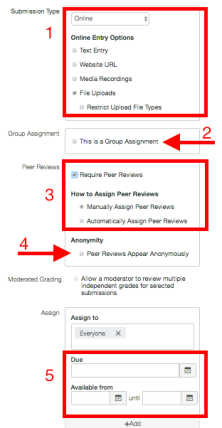
Now that we've discussed what peer review on Canvas can be used for, let's take a look at how you would do this process.
Before Setting Up Peer Review On Canvas:
You must first decide what type of peer review you would like to do.
This includes thinking through:
- what you want to accomplish pedagogically (i.e. work on a particular skill, have peers provide holistic feedback, etc.),
- when in the writing process your peer review will occur (i.e. before/after students have turned in their papers or before/after students have received feedback, etc.),
- and how students will be completing the peer review (as an in-class activity, as homework, etc.).
All of these elements will impact what the best protocol is for setting up assignments and peer review on Canvas.
Single Draft Peer Feedback
Single draft, or “traditional” peer review might be considered on a draft so that the peer feedback will work to develop a piece of writing that will later be evaluated by the instructor. This could be a formal (for a grade) or informal (not for a grade) activity in your class. For a peer review to occur before the submission of the assignment, you will need to create two assignments: one for the peer review and another for the version they want feedback from you. See an example below for details:

In the above example, "Essay 1 First Draft" is the assignment set up for students to do peer review, and the "Essay 1 Final Draft" is the assignment set up to get formally assessed by the teacher.
Multiple Drafts with Peer Feedback
If you are using multiple drafts of an assignment (e.g. Essay 2), where you would like to have students submit an essay, receive feedback from you, make revisions, and then receive peer feedback (or vice versa) you will need to create separate assignments in Canvas. In other words, you cannot create one assignment called "Essay 2" on Canvas and expect that students use that one assignment to upload the first draft to get feedback from you, then revise and upload the new draft for a peer review on the same assignment, and finally upload a final version. Instead, you must create a new assignment for each thing you want students to do with "Essay 2." You can see an example of how to do this correctly below: 
In the above example, the instructor uses "Researcher's Notebook" as the name of the assignment for the first thing they want students to do for "Essay 2": upload a pre-draft to get feedback from the instructor. Then, the "Essay 2 First Draft" is a separate assignment with peer review capabilities because the instructor wanted students to revise based on the comments on the "Researcher's Notebook" and get peer feedback on the revised draft. Finally, the last assignment is entitled "Essay 2 Final Draft," which is the last iteration of this assignment, meant to get feedback from the instructor (along with the final grade).
Discussion Board Peer Review
Another option is to use the Discussion function rather than the Assignment function in Canvas. It might be a good choice if you are planning to have students do the activity in class, and if there is a value to students being able to see everyone’s feedback.
Additional Tips:
- When naming the titles of Assignments and Discussions, you can choose what you like, just be sure to remain clear and consistent with your students.
- You can and should use different types of peer review activities. This helps to keep students engaged and meet different learning styles.
- Students will need instructions from you on how to use the type of peer review you have selected in Canvas, and also a pedagogical explanation for the value of peer review. Remember that many students (especially at the 100-level) have not used peer review, and if they have, they still might have skepticism about its benefits. Peer review is not a self-supporting activity. Like anything other type of lesson, it requires instructions, guidance, and a transparency toward purpose and function (scaffolding).
- It is always important with any activity, but especially those utilizing technology to prepare for a contingency plan. This is especially a concern if you are conducting your peer review during class time. For example, if you are doing the peer review during class and have manually assigned, a student absence might create an issue. To help prevent this, you can try assigning 3 or 4 peer reviews to each student. That way, the likelihood of issues are reduced. Or, you can wait to do the assignments on the day of. Prepare a short activity (like a free-write) while you do this in class.
- There have been some glitches with the auto-assign function, so you may need to try that again if students can't access papers immediately. However, always be mindful of the time. If you are spending too much time trying to make a function work, consider an alternative plan. Other options include having students email one another, utilize the hard drive, or look on eachothers’ screens.Try to be prepared and use your best judgment in order to best meet the needs of your class.
- If you need advice on peer review, either on thinking through it pedagogically or functionally on Canvas, please seek out the support of EWP’s CIC administrative staff. You can also visit Canvas' instructor support guide or directly contact the Canvas help team (help@uw.edu).
Setting up Peer Review Within an Assignment on Canvas
How to Set Up Peer Review Within An Assignment:
- After you’ve set up an assignment (added points, due date, and Assignment Group), click on More Options.

- Select Grading type and Submission type, then click on Require Peer Reviews.
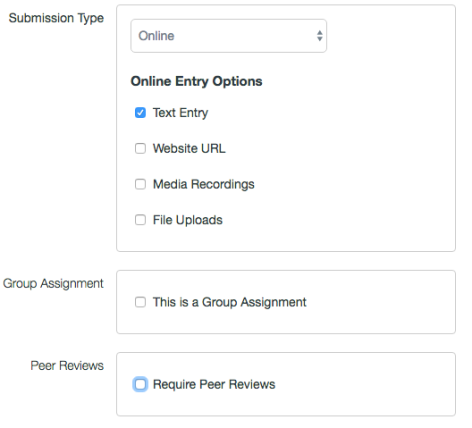
- In Canvas, you are given the option to manually assign or automatically assign peer reviews. Be strategic about this. You may want to consider pairing on the basis of proficiency (ex. a language learner and a native speaker), experience (ex. two upper-classmen), topic, gender, students who frequently work together or never have, etc. Manually assigning can have many pedagogical benefits, so make sure to consider this beforehand.

- If you decide to manually assign: Proceed to setting the Assignment’s other information.“Everyone” is typically auto-selected, but be sure to confirm that selection or update it as necessary. Select the due date, and the available from and available to sections.
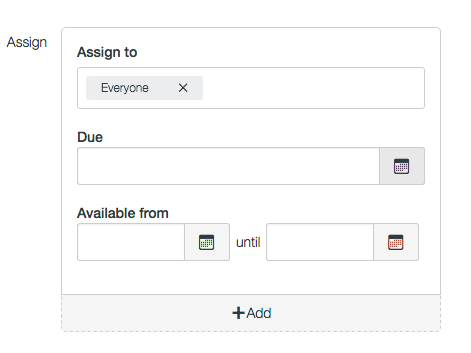
- Finally, make sure to Save or Save and Publish, depending on your preference.
Once the assignment is created, click on Assignments and go to the assignment. On the right-hand side you will see Peer Reviews. Click on it.
From there, you will see a list of your students. Here, you can go name by name and click the plus sign to select who will work with who. You can scroll down your list and click Add. If you make a mistake, you can delete by hovering over the name and clicking the trash can. Continue until everyone is assigned. You can assign more than one person each by continuing to click the plus sign. Your peer reviews will now be set for your students. Go here for more information about what students will see and how they will retrieve their peer reviews.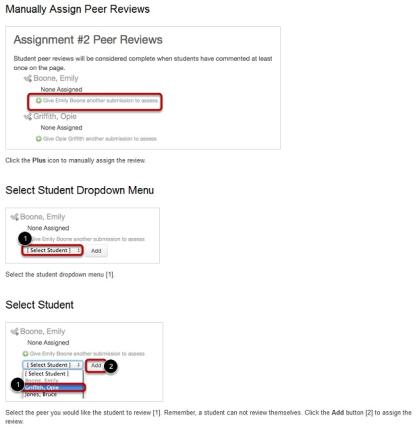
- If you choose to automatically assign peer reviews, click Automatically Assign Peer Reviews. A couple of new boxes will pop up. Set the number of reviews you want students to doin the Reviews Per User box. When deciding, think about feasibility and function. One or two times might be appropriate for a longer, more substantial review. Three or four might be appropriate for a shorter, less formal review.
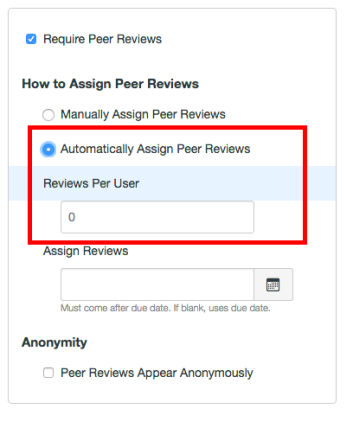
- Next, set the due date in the Assign Reviews section. Setting the due date is essential on Canvas. You MUST make the due date after assignment is due. You can put in a date if you want to, but if you don’t, the peer reviews will be assigned when students turn in papers. Remember, Canvas does not allow multiple due dates within a single assignment. Refer to the previous information to think through this. It may be appropriate to set up another assignment at this time. For more information on how students can submit their peer feedback and view their peers’ feedback once given, go here and here.
Setting up Peer Review Within a Discussion on Canvas
How to Set Up Peer Review Within A Discussion:
Another way to do peer review is with discussion boards. Discussion board peer reviews are a good choice if you want students to have access to everyone's drafts instead of just one or more that are assigned to them. There are two main ways to use discussion boards for peer review:
The first way to set up discussion board peer review is similar to what was outlined above in setting up a peer review assignment. The difference between an assignment and a discussion peer review is that students can see all students' submissions. To do a Canvas discussion peer review:
1. Go to assignments, and add an assignment by clicking the "+" button.
![]()
2. Be sure the type is listed as "Discussion." Note: it will typically have "Assignment" as the type, so use the drop down function to change it.
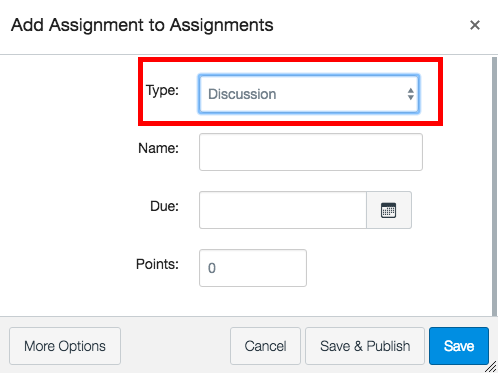
3. From here, follow the steps outlined above when creating a peer review assignment: select More Options, then Require Peer Reviews, decide if you want manual/automatic reviews, etc.
Checking Progress and Viewing Completed Reviews
- Once students have started submitting their reviews, you can return to the peer review button off of the assignments page to keep track of who has submitted.

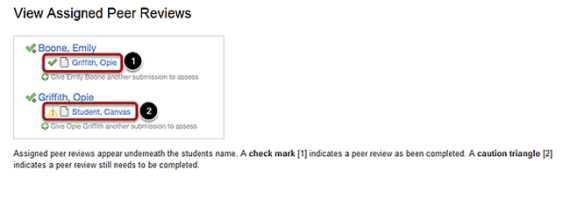
- To confirm that your peer reviews have been assigned, go to the assignments page and click the Peer Reviews button on the right hand side.
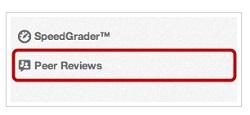
NOTE: Remember they won’t be auto assigned until they turn in. Check it after they’ve turned it in. You can use this page to check to see whether or not students have completed the reviews. There will be a green check mark if they have and a yellow exclamation point if they haven’t.
NOTE: If the student has done the review (they have done a mark-up but not left comments), they have to make at least one comment in order for the review to appear. See the Student View section to learn more. - Once all of the peer reviews have been submitted, if you would like to access the actual comments, assess, or add comments of your own, you can do so by going to the speedgrader function.
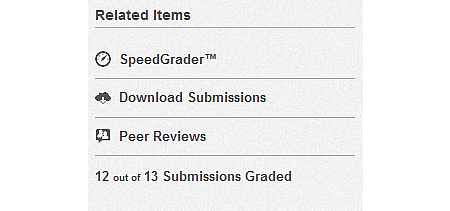
The Student View in Peer Review
1. Once students have been assigned their peer reviews, they will see a list of their assigned reviews:
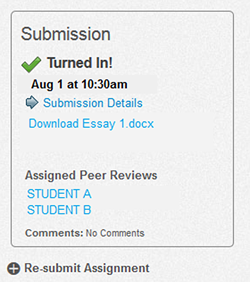
2. Next, students will click on their peers' names to access their drafts.
3. From there, a document review screen will open. Students can click the preview icon to see their peer’s text and open Canvas’s in-text comment options.

4. Students are able to comment in multiple ways, the "Add a Comment" function allows them to include a brief note.

5. Students are also able to make comments directly on the draft by using Canvas''“Comment” options, pictured below.

6. Once finished, students might want to attach a file (if appropriate), but will also need to save.

7. After saving, Canvas will display a confirmation message above your students' peer’s text. Note that they may have to refresh the page to see the message.
